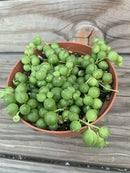Description
The succulent string of pearls, with its small green bubbles along a slender stem, recalls the plastic pop-apart beads of childhood dress-up bins. It can’t help its quirkiness.
Also known as “string of beads” or “rosary,” this succulent is a perennial vine of the Asteraceae family and is native to southwest Africa. Like most succulents, it requires very little hands-on care.
In addition to its unique foliage, string of pearls can produce tiny white flowers with bright-colored stamens. (Some say the blooms smell like cinnamon.) To encourage spring flowers, cut back on water and move the succulent to a slightly cooler area (around 60 degrees Fahrenheit) throughout the winter months.
- String of pearls does well in bright light. Consider placing it on a sunny windowsill or, if bright sunlight is limited, leave it under a fluorescent light during daylight hours.
- Make sure there’s plenty of room for your plant to sprawl. Consider displaying it in a hanging basket so tendrils can cascade downwards.
- Be sure the plant (and any fallen beads) are out of reach of children and pets: This succulent can be toxic when consumed.
- Keep string of pearls in average indoor temperatures, around 72 degrees Fahrenheit, and avoid drafty areas.
- Like most succulents, string of pearls is drought tolerant. Make sure to plant it in a pot with a drainage hole and use potting mix suitable for cacti. Soak the soil thoroughly in when watering, then make sure to let the topsoil dry out completely before watering again.
- To prune, simply trim off any bygone stems or beads.
Source - Gardenista


